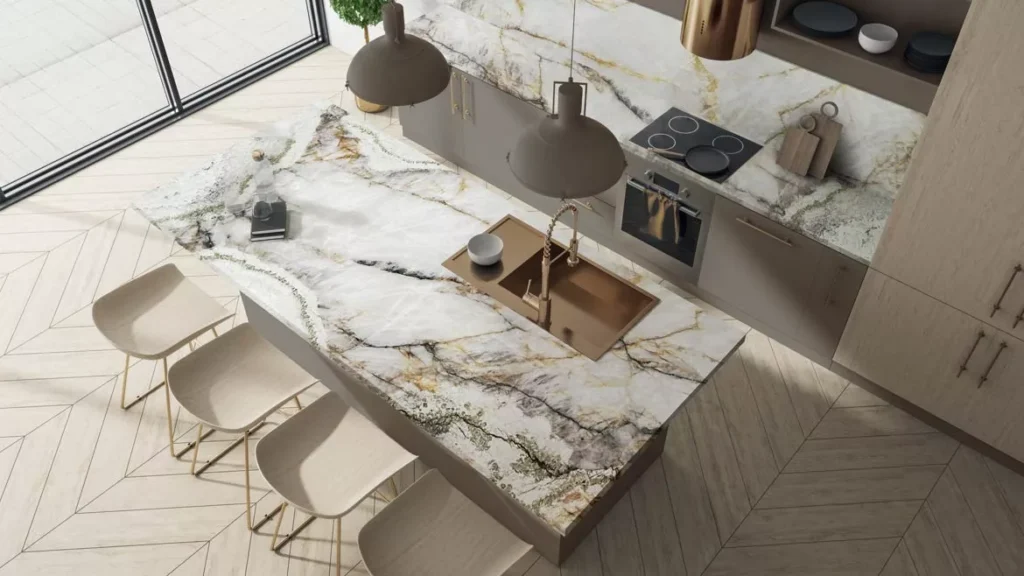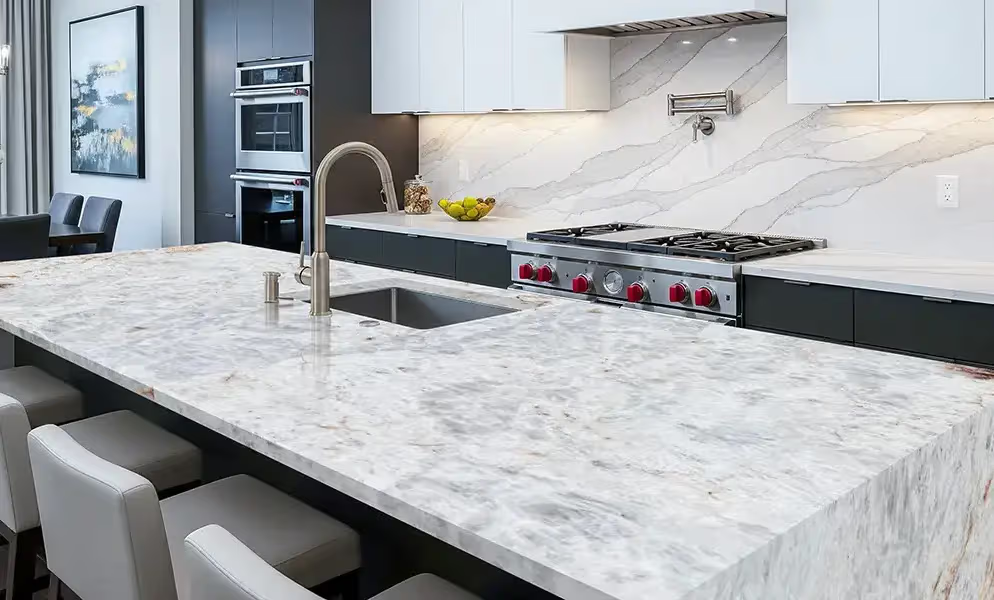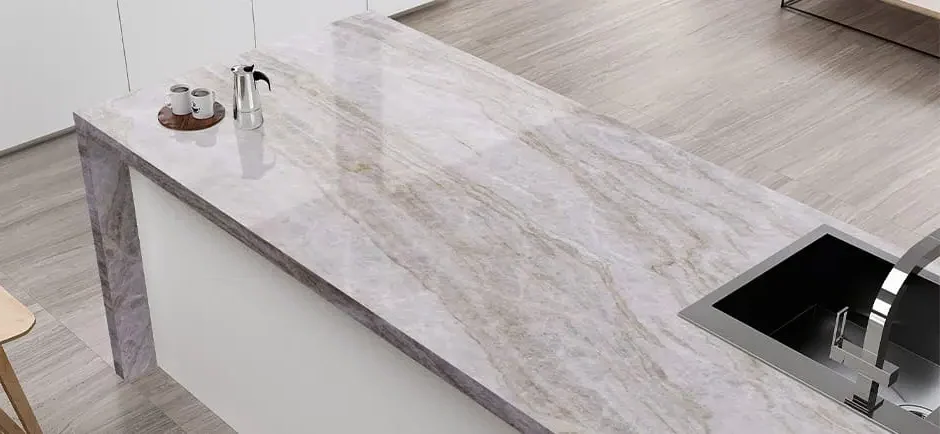


Quartzite countertops have become one of the most sought-after choices for homeowners across Ontario who want the elegance of natural stone combined with exceptional durability. Unlike quartz, which is engineered, quartzite is a natural metamorphic rock formed when sandstone is exposed to intense heat and pressure deep within the earth. This transformation gives quartzite its unique balance of beauty and resilience, making it a premium option for modern and traditional kitchens alike.
In cities like Toronto, Ottawa, Oakville, and Mississauga, quartzite is increasingly popular among homeowners aiming to boost property value while enjoying a luxurious surface that can withstand daily wear and tear. Each slab of quartzite is completely unique, offering stunning veining patterns that resemble marble while delivering the hardness and scratch resistance closer to granite. This combination makes it especially appealing to Ontario families who want a countertop that feels both timeless and practical.
Beyond aesthetics, quartzite’s natural strength allows it to handle the demands of busy kitchens, whether it’s meal preparation, family gatherings, or entertaining guests. With Ontario’s 2025 design trends focusing on blending natural textures with functionality, quartzite countertops stand out as a smart long-term investment for homeowners who want their kitchens to reflect both durability and elegance.

When it comes to choosing the right countertop material for Ontario homes, quartzite stands out for its combination of natural beauty and strength. While granite and quartz are often the first materials homeowners consider, quartzite offers a unique balance that makes it especially appealing for kitchens across Toronto, Ottawa, Mississauga, Oakville, Vaughan, and Hamilton. Below are the key advantages of quartzite countertops that explain why this material has been gaining so much popularity in recent years.
Quartzite is one of the hardest natural stones available for kitchen countertops. On the Mohs hardness scale, quartzite typically rates between 7 and 8, which means it is harder than granite and significantly more resistant to scratches than marble. For Ontario households where kitchens are high-traffic spaces—whether it’s preparing meals for a busy family in Toronto or entertaining guests in a Muskoka cottage—this durability makes quartzite a reliable long-term investment.
Unlike softer stones, quartzite does not etch or wear down easily when exposed to knives, pots, or heavy kitchenware. This makes it particularly practical for homeowners who actually use their kitchens daily, rather than just keeping them as a showpiece.
Ontario homeowners often love hosting, whether it’s Sunday family dinners in Mississauga or holiday gatherings in Ottawa. Quartzite countertops excel in these environments because they are highly heat-resistant. You can safely place hot pots and pans directly on the surface without worrying about damage—something that cannot be said for engineered quartz, which may discolor or crack under direct heat.
This heat resistance is a major advantage for anyone who cooks regularly, as it minimizes the risk of costly damage and makes the kitchen a more functional and stress-free space.
While all natural stones require some degree of care, quartzite is much easier to maintain than marble. Marble is porous and prone to staining, which is why many Ontario homeowners hesitate to install it in busy kitchens. Quartzite, by comparison, is denser and less porous, meaning that with proper sealing it resists staining and etching much more effectively.
A simple routine of sealing the surface once or twice a year, along with wiping spills quickly, ensures that quartzite countertops will retain their stunning look for decades. This balance of natural beauty with relatively low maintenance is a major selling point for homeowners balancing aesthetics and practicality.
One of the biggest advantages of quartzite countertops is their appearance. Each slab is unique, featuring natural veining patterns that often resemble marble. For Ontario homeowners who want the elegance of marble but the durability of granite, quartzite provides the perfect middle ground.
The color palette of quartzite ranges from soft whites and creams to bold grays, blues, and greens. This variety makes it easy to pair with different kitchen designs—from modern minimalist condos in downtown Toronto to rustic farmhouse kitchens in rural Ontario. Because each piece is one-of-a-kind, quartzite instantly elevates the look of any home, adding a touch of exclusivity and sophistication.
Installing quartzite countertops is an investment that pays off in Ontario’s competitive real estate market. Whether you are upgrading a kitchen in Oakville, where luxury homes are highly sought-after, or modernizing a property in downtown Ottawa, quartzite adds tangible value. Potential buyers appreciate the combination of natural beauty, strength, and longevity, making it easier to command a higher resale price.
In fact, real estate agents across Ontario often highlight quartzite countertops in listings as a premium feature, similar to hardwood floors or stainless steel appliances. For homeowners planning to sell within the next 5–10 years, quartzite is one of the smartest kitchen upgrades available.
Ontario homeowners often consider countertops as a one-time investment, and quartzite aligns perfectly with that mindset. With proper care, quartzite countertops can last a lifetime. Unlike laminate, butcher block, or even quartz, which may show wear and tear over time, quartzite maintains its original beauty for decades.
This long-term performance is especially appealing for homeowners who want to avoid the hassle and expense of replacing countertops every 10–15 years. Once installed, quartzite becomes a permanent and timeless part of the kitchen.
With growing environmental awareness in Ontario, more homeowners are looking for eco-friendly building materials. Quartzite is a natural stone that requires minimal processing compared to engineered materials like quartz, which involve resins and industrial production. Choosing quartzite means reducing reliance on synthetic materials and embracing a more natural, sustainable option.
Additionally, because quartzite lasts so long, it reduces the environmental impact of frequent replacements. This sustainability factor makes it a great fit for eco-conscious homeowners in Ontario cities like Guelph, Waterloo, and Kingston.
Another key advantage of quartzite countertops is their versatility. Whether you are designing a modern white-on-white kitchen in Toronto or a warm, rustic-style space in Muskoka, quartzite adapts beautifully to a wide range of aesthetics.
In modern kitchens, quartzite’s sleek look pairs well with flat-panel cabinets and stainless steel appliances.
In traditional kitchens, the natural veining complements wood cabinetry and classic design elements.
In luxury homes, rare quartzite slabs with bold colors and dramatic veining act as a focal point, often replacing marble islands.
This versatility makes quartzite an appealing choice for Ontario homeowners who want both flexibility and timeless appeal.

While quartzite countertops bring undeniable beauty and durability to Ontario kitchens, they are not without drawbacks. Like every natural stone, quartzite has its limitations, and homeowners should carefully weigh these challenges before committing. Below are the most important cons of quartzite countertops, explained with a focus on how they affect Ontario homeowners in cities such as Toronto, Ottawa, Mississauga, Oakville, Vaughan, and Hamilton.
One of the biggest disadvantages of quartzite countertops is the price. On average, quartzite costs more than granite and can be similar in price—or sometimes higher—than engineered quartz. In Ontario, homeowners can expect to pay $90 to $150 per square foot for installed quartzite, depending on the quality and rarity of the slab.
This makes quartzite a luxury option, especially when compared to mid-range alternatives like laminate, solid surface, or butcher block. For homeowners renovating a starter home in Oshawa or Hamilton, the upfront investment may feel steep. Even in higher-end markets like Oakville or downtown Toronto, the cost can significantly impact the overall kitchen renovation budget.
Quartzite is less porous than marble, but it is still a natural stone that requires sealing. Without proper sealing, it is vulnerable to stains from common kitchen substances like wine, coffee, oils, and acidic juices. Ontario homeowners who entertain often or have children need to be especially mindful, as unsealed quartzite can quickly lose its pristine appearance.
Sealing is not particularly difficult, but it must be done once or twice a year depending on usage. This ongoing maintenance can feel inconvenient for busy homeowners in urban centers like Toronto and Ottawa, who may prefer a low-maintenance alternative such as engineered quartz.
While quartzite offers stunning natural veining and a variety of tones, its color palette is not as wide as engineered quartz. Most quartzite slabs come in shades of white, gray, beige, and sometimes soft blues or greens. For homeowners in Ontario seeking bold colors—like jet black, bright red, or pure white—engineered quartz provides far more flexibility.
This limited range can be a dealbreaker for those looking to match specific design themes in modern Toronto condos or high-contrast kitchens in Vaughan. Each quartzite slab is unique, which is both a strength and a limitation; finding the perfect color and pattern may require patience and compromise.
Quartzite’s extreme hardness, while excellent for durability, makes it difficult to cut and fabricate. This creates two challenges for Ontario homeowners:
Longer lead times – Fabricators need more specialized tools and techniques, which can delay installation compared to granite or quartz.
Higher installation costs – Because of the added labor and complexity, the fabrication and installation of quartzite countertops are often more expensive.
In smaller Ontario markets outside Toronto or Ottawa, it may even be harder to find skilled fabricators with experience in quartzite. This can add stress and unpredictability to the renovation process.
Although quartzite is extremely hard, it is not indestructible. Its hardness makes it resistant to scratches, but it can also be brittle. The edges and corners of quartzite countertops are particularly vulnerable to chipping if heavy pots or sharp objects strike them.
For families in Ontario with young children or busy kitchens, this is an important consideration. While chips can be repaired, the repair may not fully restore the seamless look of the countertop. Choosing edge profiles such as bullnose or beveled edges can reduce this risk, but it remains a potential downside.
Some quartzite slabs contain minerals that react to acidic substances like lemon juice, vinegar, or tomato sauce. This reaction can cause etching, which appears as dull spots on the surface. Although etching is less common in quartzite than marble, it is still possible depending on the specific slab.
In Ontario kitchens where cooking with fresh ingredients is common, this risk cannot be ignored. Even with sealing, the safest approach is to use cutting boards and wipe spills immediately—extra steps that some homeowners may find inconvenient.
Quartzite is extremely heavy, even compared to granite. This weight means that cabinets must be structurally sound to support the stone. In older Ontario homes—particularly century homes in Toronto or Ottawa—reinforcements may be required before installation.
This adds extra costs and can complicate renovations. In contrast, engineered quartz or lighter materials may be easier to install without structural upgrades.
Unlike granite, which is widely available, quartzite is more limited in supply. Many quartzite slabs are imported from Brazil, India, and other countries, which can create availability issues in Ontario showrooms. Certain rare varieties, like Taj Mahal Quartzite, are especially hard to source and may have long wait times.
Limited supply also drives up cost. For homeowners on a tight renovation schedule in cities like Mississauga or Vaughan, waiting for the perfect slab can delay an entire project.
While the disadvantages of quartzite are real, many Ontario homeowners still choose it because the benefits outweigh the drawbacks. For luxury homes in Oakville or Vaughan, the higher price may not be an issue. For families in Toronto or Ottawa, the need for sealing is often accepted as a small trade-off for the stone’s natural beauty and durability.
Ultimately, the key is understanding what these cons mean in the context of your specific lifestyle, kitchen usage, and budget. A homeowner who prioritizes low maintenance and affordability may lean toward engineered quartz, while someone who values natural beauty and long-term durability may find quartzite worth every penny.

Quartzite is often described as a “luxury stone” for Ontario kitchens, and with good reason. While its beauty and durability are unmatched, quartzite is also one of the more expensive countertop materials on the market. For Ontario homeowners, understanding the true cost of quartzite countertops—from slab selection to installation—is critical for making a smart investment.
In this section, we’ll break down the average costs, factors that influence pricing, and provide a practical buying guide for Ontario homeowners considering quartzite countertops in 2025.
On average, quartzite countertops in Ontario cost between $90 and $150 per square foot installed. For higher-end or exotic quartzite slabs, prices can reach $180 to $250 per square foot.
Here’s a typical cost breakdown for quartzite in Ontario:
| Type of Quartzite | Average Cost per Sq. Ft. (Installed) | Notes |
|---|---|---|
| Standard Quartzite | $90 – $120 | Most common slabs in Ontario showrooms |
| Premium Quartzite | $120 – $150 | Higher-quality slabs with more unique veining |
| Exotic Quartzite | $180 – $250 | Rare stones like Taj Mahal or White Macaubas |
A medium-sized kitchen (50 sq. ft. of countertop space) can cost anywhere from $4,500 to $7,500 with standard quartzite, while high-end selections may exceed $10,000 to $12,000.
Several factors determine the final price of quartzite countertops for Ontario homeowners:
Exotic quartzite varieties, such as Taj Mahal, White Macaubas, or Azul Macaubas, command premium pricing due to rarity.
More common quartzite colors (gray, beige, white) are typically lower priced.
Standard thickness is 3 cm (1 ¼ inches), but thicker slabs (4 cm or more) are more expensive.
Thicker slabs are common in luxury kitchens in Oakville, Vaughan, and Muskoka cottages.
Quartzite’s extreme hardness makes fabrication more difficult, which raises installation costs compared to granite or quartz.
Intricate edge designs, waterfall panels, or custom cut-outs for sinks and cooktops add to the price.
In the Greater Toronto Area (GTA), competition among suppliers keeps prices relatively competitive.
In smaller Ontario towns or northern regions, limited availability may raise costs.
Quartzite is often imported from Brazil and India. Changes in shipping costs, currency fluctuations, and demand in Ontario’s real estate market directly affect countertop pricing.
Despite the higher upfront cost, quartzite offers excellent long-term value for Ontario homeowners:
Durability – With proper sealing, quartzite can last decades without losing its beauty.
Resale Value – Homes in Toronto, Oakville, and Ottawa with quartzite countertops often sell faster and at higher prices.
Luxury Appeal – Quartzite elevates kitchens into a high-end category, which is particularly attractive in Ontario’s competitive housing markets.
When compared to marble, quartzite offers similar natural beauty but with far superior durability. Compared to engineered quartz, it provides a more unique, high-end look that cannot be replicated.
If you’re considering quartzite for your Ontario kitchen, here’s a step-by-step buying guide:
Visit suppliers in the GTA (Toronto, Mississauga, Vaughan) or Ottawa to view slabs in person.
Remember: each slab is unique—pictures online won’t capture the full effect.
Ensure you understand the sealing requirements of your chosen quartzite.
Ask suppliers how often sealing will be required based on Ontario’s climate and your kitchen usage.
Look at at least 2–3 suppliers to compare slab quality, veining, and price.
Ask about availability and whether the slab is in-stock or special-order (which can add weeks).
Because quartzite is hard to cut, installation costs vary significantly among fabricators.
Request itemized quotes for cutting, edging, installation, and sealing.
Rounded edges like bullnose or bevel are recommended for quartzite to reduce chipping.
If you want waterfall islands or thick slabs, be prepared for higher costs.
If you cook frequently, entertain, or have kids, quartzite is durable but requires maintenance.
If you want low-maintenance luxury, engineered quartz may be a better fit.
Quartzite countertops are a premium investment—but for many Ontario homeowners, the beauty, durability, and resale value justify the cost. They shine in luxury homes in Oakville, modern condos in Toronto, and upscale family kitchens in Vaughan or Ottawa.
However, they’re not for everyone. If you prefer low-maintenance and budget-friendly options, engineered quartz or granite may be a better match.
In the end, the decision comes down to balancing lifestyle, budget, and long-term goals. For Ontario homeowners who value natural beauty and want a statement piece that will last for decades, quartzite remains one of the most practical yet luxurious choices available.